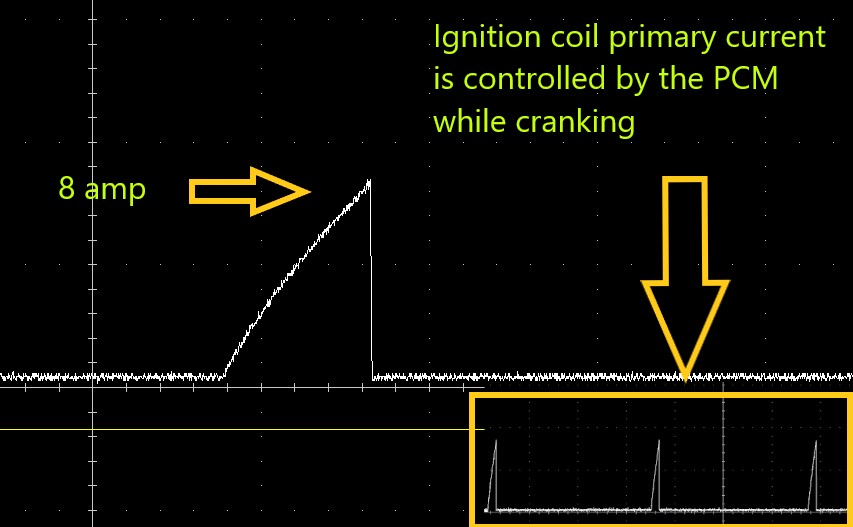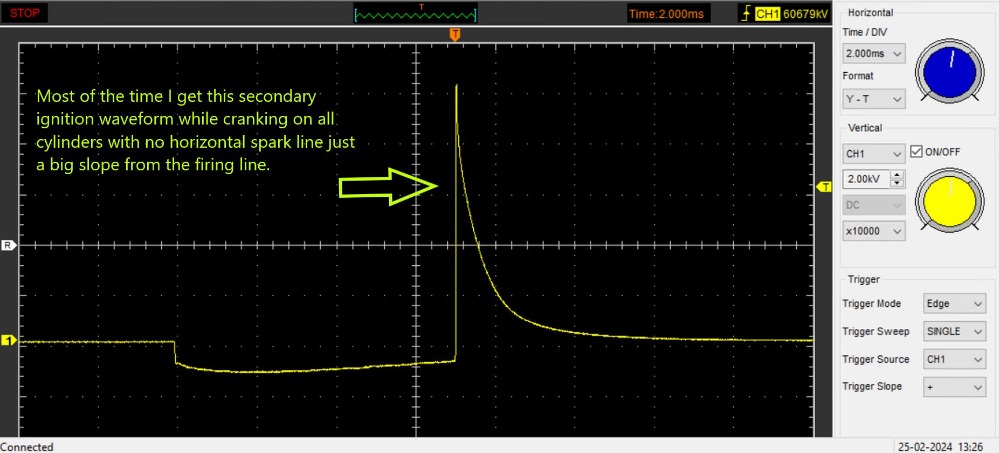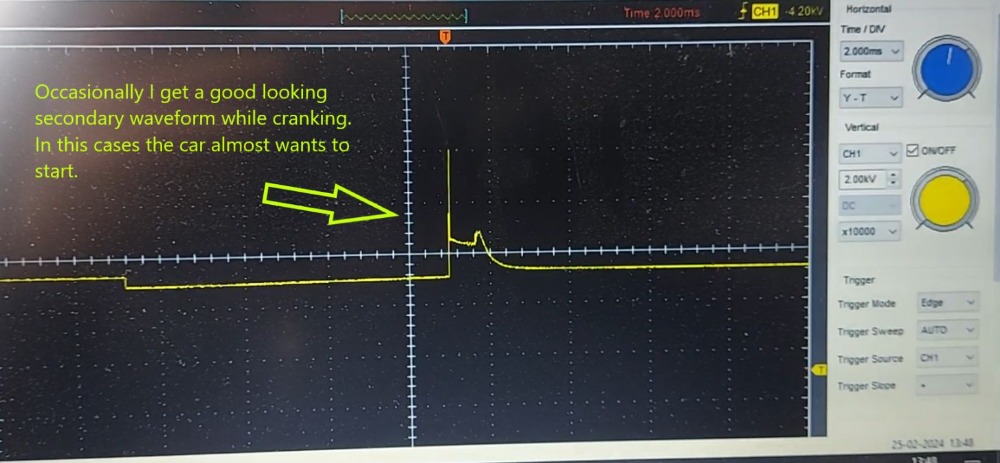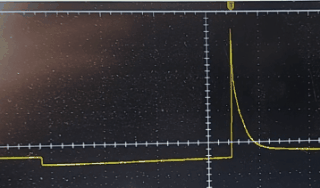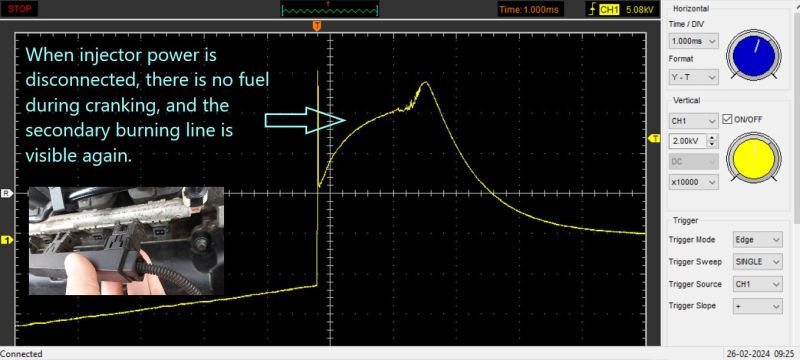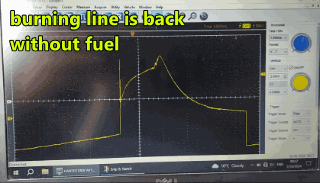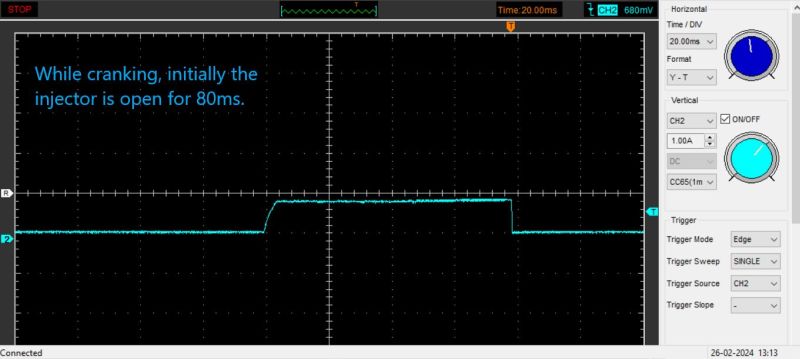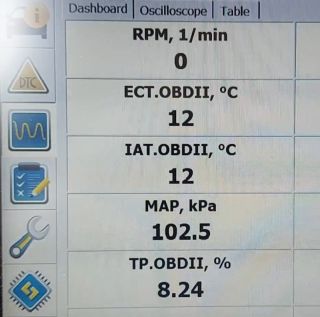Help us help you. By posting the year, make, model and engine near the beginning of your help request, followed by the symptoms (no start, high idle, misfire etc.) Along with any prevalent Diagnostic Trouble Codes, aka DTCs, other forum members will be able to help you get to a solution more quickly and easily!
[FIXED] Ford Focus 1.6L 2005 (EU), crank no start no code, strange ignition
- glongprr
-
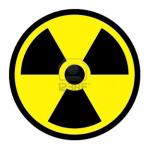 Topic Author
Topic Author
- Offline
- New Member
-

Less
More
- Posts: 5
- Thank you received: 2
1 year 10 months ago - 1 year 10 months ago #64662
by glongprr
Ford Focus 1.6L 2005 (EU), crank no start no code, strange ignition waveform was created by glongprr
The car was running fine. One morning, it started for 2 seconds then died. I checked the fuel pressure, which was low (15 psi). I replaced the fuel pump, that fixed the fuel pressure issue (50 psi), but the car now won't start. It cranks, sometimes almost wants to start. There are no DTC error codes. I couldn't find any obvious problems except for a strange secondary ignition waveform.
What I checked
What I didn't check
What I noticed
While checking the secondary ignition with a scope, I noticed a strange secondary waveform with no spark line. (see: image ) Occasionally, it produced a correct secondary waveform with the horizontal spark line (see: image ), and the car wants to start in these cases. All cylinders produce this bad secondary waveform. Here is how it looks like on the scope: image
Also a short video that shows cranking with bad secondary waveform and you`ll see it produces a good waveform and the car almost wants to start: streamable.com/a6mzgv
Occasionally, I can hear small booms (explosions) from the throttle body while cranking. I guess unburnt fuel exits through the intake valve.
I replaced the ignition coil, but the problem stayed the same. No spark line in the secondary waveform. I tried to find similar bad waveforms on the net with some explanation, but no luck. I have no idea what can cause such a bad secondary waveform without a spark line. HT leads? Spark plugs? Its like something is blocking the spark from forming. Do you have any idea?
What I checked
- Fuel pressure (50 psi, and it can hold)
- Compression: I conducted a relative compression test, which looks good, and the engine sounds good.
- Fuel injectors: There is PCM control while cranking, not stuck open or closed. Also, tested flow looks good.
- Crank sensor: OBD scan tool correctly shows the RPM while cranking.
- Cam sensor: Checked with a scope, inductive type. Waveform looks good.
- MAP sensor: OBD scan tool correctly shows vacuum in the intake while cranking.
- Throttle body: Visually inspected, clean and not clogged.
- Vacuum leaks: Did a smoke test, no vacuum leak in the air intake.
- Engine timing: Visually checked timing marks on the engine; timing is correct.
- Spark: Sparks coming out of the spark plug boot while cranking; there is PCM control.
- Ignition coil: It is a waste spark system; the coil pack gets power (12V), and PCM provides enough current (8 amp) when firing the coils. (see: image )
- Spark plugs: They look good, with 3-4 kOhm resistance.
- HT leads: Have good resistance, 2-5 kOhm depending on their length.
What I didn't check
- Exhaust back pressure: The car ran fine before; I think there is a minimal chance that it is clogged.
- Absolute compression: The engine sounds good while cranking, so I skipped this for now.
What I noticed
While checking the secondary ignition with a scope, I noticed a strange secondary waveform with no spark line. (see: image ) Occasionally, it produced a correct secondary waveform with the horizontal spark line (see: image ), and the car wants to start in these cases. All cylinders produce this bad secondary waveform. Here is how it looks like on the scope: image
Also a short video that shows cranking with bad secondary waveform and you`ll see it produces a good waveform and the car almost wants to start: streamable.com/a6mzgv
Occasionally, I can hear small booms (explosions) from the throttle body while cranking. I guess unburnt fuel exits through the intake valve.
I replaced the ignition coil, but the problem stayed the same. No spark line in the secondary waveform. I tried to find similar bad waveforms on the net with some explanation, but no luck. I have no idea what can cause such a bad secondary waveform without a spark line. HT leads? Spark plugs? Its like something is blocking the spark from forming. Do you have any idea?
Last edit: 1 year 10 months ago by glongprr. Reason: added more context
Please Log in or Create an account to join the conversation.
- Tyler
-

- Offline
- Moderator
-

- Full time HACK since 2012
Less
More
- Posts: 6063
- Thank you received: 1531
1 year 10 months ago #64663
by Tyler
Replied by Tyler on topic Ford Focus 1.6L 2005 (EU), crank no start no code, strange ignition waveform
Love the secondary captures.
Thanks for including those!
That gentle slope down from the firing line is usually an indication of a secondary circuit short to ground, IMO. Water in the spark plug tubes, coolant/fluid across the spark plug gap, wire grounding out, like that. Not saying your Focus actually has any of those specific problems. Just giving examples of what I've seen cause that ignition waveform.
The engine doesn't sound like the piston rings are washed out, but I'd be tempted to pull the spark plugs and check for fouling anyway. If the plugs are wet with gas, dry them and the cylinder out as best you can. You can also try feathering the throttle during cranking in an attempt to get the cylinders dried out enough to start. Take care not to overheat the starter, and have a battery charger/jump pack handy.
Speaking of gas, was the vehicle refueled immediately prior to no start happening? How did the fuel in the tank look when you replaced the pump?
That gentle slope down from the firing line is usually an indication of a secondary circuit short to ground, IMO. Water in the spark plug tubes, coolant/fluid across the spark plug gap, wire grounding out, like that. Not saying your Focus actually has any of those specific problems. Just giving examples of what I've seen cause that ignition waveform.
The engine doesn't sound like the piston rings are washed out, but I'd be tempted to pull the spark plugs and check for fouling anyway. If the plugs are wet with gas, dry them and the cylinder out as best you can. You can also try feathering the throttle during cranking in an attempt to get the cylinders dried out enough to start. Take care not to overheat the starter, and have a battery charger/jump pack handy.
Speaking of gas, was the vehicle refueled immediately prior to no start happening? How did the fuel in the tank look when you replaced the pump?
Please Log in or Create an account to join the conversation.
- glongprr
-
 Topic Author
Topic Author
- Offline
- New Member
-

Less
More
- Posts: 5
- Thank you received: 2
1 year 10 months ago #64666
by glongprr
Replied by glongprr on topic Ford Focus 1.6L 2005 (EU), crank no start no code, strange ignition waveform
Thanks for the reply!
Hmm, the spark plugs are wet after cranking. I also removed them all and trien to dry the cylider but that didn`t fix the issue.
The valve cover was leaking oil, and some oil seeped into the spark plug well. Additionally, the spark plug boots had some oil on them. However, I suppose that shouldn't cause an instant no crank. When I removed the spark plugs their thread and electrode were covered with oil, but I cleaned them all. Here is an image of the spark plugs after cleaning.
The fuel tank looked clean while I was replacing the pump. The car was used daily, so it was refueled probably a few days before the no start.
See the image of the spark plug well:
Hmm, the spark plugs are wet after cranking. I also removed them all and trien to dry the cylider but that didn`t fix the issue.
The valve cover was leaking oil, and some oil seeped into the spark plug well. Additionally, the spark plug boots had some oil on them. However, I suppose that shouldn't cause an instant no crank. When I removed the spark plugs their thread and electrode were covered with oil, but I cleaned them all. Here is an image of the spark plugs after cleaning.
The fuel tank looked clean while I was replacing the pump. The car was used daily, so it was refueled probably a few days before the no start.
See the image of the spark plug well:
Please Log in or Create an account to join the conversation.
- Tyler
-

- Offline
- Moderator
-

- Full time HACK since 2012
Less
More
- Posts: 6063
- Thank you received: 1531
1 year 10 months ago #64673
by Tyler
Replied by Tyler on topic Ford Focus 1.6L 2005 (EU), crank no start no code, strange ignition waveform
You're right, the valve cover gasket leaking onto the plugs is a problem, but won't cause a no start like this. Since you indicated the car gets driven daily and refueled a few days ago, I'm gonna figure that bad gas is probably not a suspect.
At this point I'd consider adding a teaspoon of engine oil or transmission fluid to each cylinder, put the plugs back in and feather the throttle during cranking. If you can get a hold of some replacement plugs, that'd be even better.
I'd also suggest having a look at scan data during cranking for the cranking injection pulse width, and the engine coolant temperature. The ECT should be pretty close to ambient temperature. An ECT that's incorrectly reporting the coolant temperature to be way lower than it actually is can cause overfueling, which we could see in the cranking injection pulse width.
At this point I'd consider adding a teaspoon of engine oil or transmission fluid to each cylinder, put the plugs back in and feather the throttle during cranking. If you can get a hold of some replacement plugs, that'd be even better.
I'd also suggest having a look at scan data during cranking for the cranking injection pulse width, and the engine coolant temperature. The ECT should be pretty close to ambient temperature. An ECT that's incorrectly reporting the coolant temperature to be way lower than it actually is can cause overfueling, which we could see in the cranking injection pulse width.
Please Log in or Create an account to join the conversation.
- glongprr
-
 Topic Author
Topic Author
- Offline
- New Member
-

Less
More
- Posts: 5
- Thank you received: 2
1 year 10 months ago - 1 year 10 months ago #64695
by glongprr
Replied by glongprr on topic [FIXED] Ford Focus 1.6L 2005 (EU), crank no start no code, strange ignition
Thanks, Tyler! Your hint regarding the fuel injectors was really helpful!
The secondary burn line is back (without fuel)
I thought that if the missing burn line in the secondary waveform is caused by a fuel issue, then simply cutting the fuel while cranking should show a change in the secondary waveform. So, I disconnected the injectors from the power and checked the waveform again. Now, the burn line in the secondary waveform appeared, confirming that the issue is definitely caused by fuel in the cylinder, and the ignition system is fine.
Here is the video of the secondary waveform with the reappeared burn line while cranking.
As you can see no the burn line is definetly visible while cranking whithout fuel:
The injector curret test was good
I checked the fuel injector current waveform, and the PCM definitely controls the injectors, creating a quite long pulse of 80ms while cranking. As I mentioned, I already checked the injectors; they are neither stuck open nor closed and can hold pressure. Additionally, I performed an injector balance test, and all injectors were found to be in good condition.
Here is the video of the injector current while cranking.
Injector pulse related sensors look good (except one)
Now, I suspect that the PCM floods the cylinders with fuel, preventing the plugs from producing a spark. As you suggested, I checked all the sensors that might be related to injector pulse while cranking:
What I suspect after the tests above
I noticed that the throttle plate in the throttle body doesn't move when the key is on but not cranking, even when I move the accelerator pedal. Additionally, it remains stationary while cranking. It's an electronic throttle body, and I'm unsure if this is normal. I would expect the throttle plate to be moved by the PCM, at least when cranking. Thus, I suspect something strange with the throttle plate control. However, if the computer detects that it commands the throttle plate to move and it doesn't, it should set an error code. Yet, as I mentioned, there are no codes.
In this video I show that when it is key on engine off, I move the accelerator pedal but the throttleplate not moving, it just clicks when I turn off the key. (background noise)
As far as I know, these Fords have a problem with the instrument cluster. The solder joints can crack, causing various electrical problems and error codes. The instrument cluster in this specific car has been repaired twice already due to cracked solder joints. However, when this issue occurred previously, it was obvious; the instrument cluster lights were blinking, and various communication error codes were displayed (including throttle body). Moreover, in this model, the throttle is controlled by the instrument cluster. But since there are no codes, I'm not sure if the instrument cluster is causing this issue.
The secondary burn line is back (without fuel)
I thought that if the missing burn line in the secondary waveform is caused by a fuel issue, then simply cutting the fuel while cranking should show a change in the secondary waveform. So, I disconnected the injectors from the power and checked the waveform again. Now, the burn line in the secondary waveform appeared, confirming that the issue is definitely caused by fuel in the cylinder, and the ignition system is fine.
Here is the video of the secondary waveform with the reappeared burn line while cranking.
As you can see no the burn line is definetly visible while cranking whithout fuel:
The injector curret test was good
I checked the fuel injector current waveform, and the PCM definitely controls the injectors, creating a quite long pulse of 80ms while cranking. As I mentioned, I already checked the injectors; they are neither stuck open nor closed and can hold pressure. Additionally, I performed an injector balance test, and all injectors were found to be in good condition.
Here is the video of the injector current while cranking.
Injector pulse related sensors look good (except one)
Now, I suspect that the PCM floods the cylinders with fuel, preventing the plugs from producing a spark. As you suggested, I checked all the sensors that might be related to injector pulse while cranking:
- Engine coolant temperature (ETC): 12°C (53°F) - matches the actual ambient temperature
- Intake air temperature (IAT): 13°C (55°F) - matches the actual ambient temperature
- MAP: shows vacuum while cranking
- Throttle position (TP): I was moving the accelerator pedal while cranking and I could see throttle position value changing on the scan tool. (In reality it was not moving.)
What I suspect after the tests above
I noticed that the throttle plate in the throttle body doesn't move when the key is on but not cranking, even when I move the accelerator pedal. Additionally, it remains stationary while cranking. It's an electronic throttle body, and I'm unsure if this is normal. I would expect the throttle plate to be moved by the PCM, at least when cranking. Thus, I suspect something strange with the throttle plate control. However, if the computer detects that it commands the throttle plate to move and it doesn't, it should set an error code. Yet, as I mentioned, there are no codes.
In this video I show that when it is key on engine off, I move the accelerator pedal but the throttleplate not moving, it just clicks when I turn off the key. (background noise)
As far as I know, these Fords have a problem with the instrument cluster. The solder joints can crack, causing various electrical problems and error codes. The instrument cluster in this specific car has been repaired twice already due to cracked solder joints. However, when this issue occurred previously, it was obvious; the instrument cluster lights were blinking, and various communication error codes were displayed (including throttle body). Moreover, in this model, the throttle is controlled by the instrument cluster. But since there are no codes, I'm not sure if the instrument cluster is causing this issue.
Last edit: 1 year 10 months ago by glongprr. Reason: fixed
Please Log in or Create an account to join the conversation.
- glongprr
-
 Topic Author
Topic Author
- Offline
- New Member
-

Less
More
- Posts: 5
- Thank you received: 2
1 year 10 months ago - 1 year 10 months ago #64744
by glongprr
Replied by glongprr on topic [FIXED] Ford Focus 1.6L 2005 (EU), crank no start no code, strange ignition
Okay, so now the car is running. As I mentioned, I had a sudden crank with no start. I checked everything, and everything looked good. While I was checking the secondary waveform, it looked strange. I haven't seen anything like it anywhere else on the internet, not even anything similar. Based on Tyler's suggestion, I ended up checking the fuel-related stuff again. When I completely cut the fuel while cranking, the secondary waveform looked normal.
This suggested that the waveform I'm looking at means that the cylinder is flooded with fuel, and the spark plug is not able to create a good spark. Why is the cylinder flooded with fuel? Is it because there is no air? I checked the electric throttle body, and the butterfly valve was not moving while I was pressing on the accelerator pedal (also, there were no DTC codes). So, the PCM detected the accelerator pedal movement but didn't control the butterfly valve for some reason.
I ended up resetting the PCM and all other modules in the car and sprayed a ton of brake cleaner into the throttle body while cranking. That caused something to happen; the engine started, and the butterfly valve in the throttle body was now controlled again by the PCM. So the car runs fine now.
Maybe it was a glitch in the PCM that somehow fixed itself by resetting it and spraying brake clean. I'm not happy with this fix; it is totally confusing. But if there is some sort of error that cannot be explained, just reset the PCM and the other modules as the last resort.
This suggested that the waveform I'm looking at means that the cylinder is flooded with fuel, and the spark plug is not able to create a good spark. Why is the cylinder flooded with fuel? Is it because there is no air? I checked the electric throttle body, and the butterfly valve was not moving while I was pressing on the accelerator pedal (also, there were no DTC codes). So, the PCM detected the accelerator pedal movement but didn't control the butterfly valve for some reason.
I ended up resetting the PCM and all other modules in the car and sprayed a ton of brake cleaner into the throttle body while cranking. That caused something to happen; the engine started, and the butterfly valve in the throttle body was now controlled again by the PCM. So the car runs fine now.
Maybe it was a glitch in the PCM that somehow fixed itself by resetting it and spraying brake clean. I'm not happy with this fix; it is totally confusing. But if there is some sort of error that cannot be explained, just reset the PCM and the other modules as the last resort.
Last edit: 1 year 10 months ago by glongprr. Reason: fix typo
The following user(s) said Thank You: Tyler, Latino4Trump2024
Please Log in or Create an account to join the conversation.
- Tyler
-

- Offline
- Moderator
-

- Full time HACK since 2012
Less
More
- Posts: 6063
- Thank you received: 1531
1 year 10 months ago #64776
by Tyler
Replied by Tyler on topic [FIXED] Ford Focus 1.6L 2005 (EU), crank no start no code, strange ignition
Glad to hear it's fixed!
Many thanks for the follow up. Appreciate the [FIXED].
Any thoughts as to why the spark plug fouling started in the first place? If you were to take injector power away again and crank the engine, does the PCM allow you to open the throttle with accelerator pedal inputs? Don't mean to interrogate you, just thinking out loud about the root cause.
Any thoughts as to why the spark plug fouling started in the first place? If you were to take injector power away again and crank the engine, does the PCM allow you to open the throttle with accelerator pedal inputs? Don't mean to interrogate you, just thinking out loud about the root cause.
Please Log in or Create an account to join the conversation.
- glongprr
-
 Topic Author
Topic Author
- Offline
- New Member
-

Less
More
- Posts: 5
- Thank you received: 2
1 year 10 months ago - 1 year 10 months ago #64837
by glongprr
Replied by glongprr on topic [FIXED] Ford Focus 1.6L 2005 (EU), crank no start no code, strange ignition
I couldn't directly identify the cause of the spark plug fouling. The car is usually used for very short daily trips (2-3 miles), so it doesn't have enough time to heat up properly. Additionally, the leaking valve cover could be causing oil to seep through the plug. It's possible that the combination of these factors contributed to the fouling
Even with the injectors disconnected, the PCM didn't control the throttle when I moved the accelerator pedal.
Resetting all the modules and the PCM (including removing the battery) triggered something, and the PCM finally started to control the throttle. I was completely surprised. I didn't expect that a PCM reset would solve the issue.
Even with the injectors disconnected, the PCM didn't control the throttle when I moved the accelerator pedal.
Resetting all the modules and the PCM (including removing the battery) triggered something, and the PCM finally started to control the throttle. I was completely surprised. I didn't expect that a PCM reset would solve the issue.
Last edit: 1 year 10 months ago by glongprr. Reason: fix typo
Please Log in or Create an account to join the conversation.
- Szabolcs
-
- Offline
- New Member
-

Less
More
- Posts: 1
- Thank you received: 0
9 months 5 days ago #86953
by Szabolcs
Replied by Szabolcs on topic [FIXED] Ford Focus 1.6L 2005 (EU), crank no start no code, strange ignition
Hey guys!
I have a very similar problem. I have the same car (Focus, MkII 1.6 petrol HWDA engine).
I checked the same things as you, but my car still wont start. Did you happen to find the root of the problem in the end?
What can you recommend for me?
Shall I replace the PCM module (if yes, where is it)? The crankcase pressure seems pretty high (but I cant tell exact measures). On the tube on the valve cover I feel vacuum, can this be related to the problem?
Thanks a lot for answering.
I have a very similar problem. I have the same car (Focus, MkII 1.6 petrol HWDA engine).
I checked the same things as you, but my car still wont start. Did you happen to find the root of the problem in the end?
What can you recommend for me?
Shall I replace the PCM module (if yes, where is it)? The crankcase pressure seems pretty high (but I cant tell exact measures). On the tube on the valve cover I feel vacuum, can this be related to the problem?
Thanks a lot for answering.
Please Log in or Create an account to join the conversation.
Time to create page: 0.365 seconds

